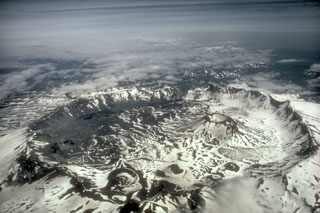Intrigued with the science of Supervolcanoes, the following was discovered. There are 11 known supervolcanos, five of which are in the USA; four on the main continent, one in Alaska. This was very surprising. All have the same characteristic hot springs and geysers. Check out the link to get information on each caldera.
http://www.answers.com/topic/supervolcano&method=8
Mount Aniakchak, Alaska, United States
Aso, Kyūshū, Japan
Campi Flegrei, Campania, Italy
Kikai Caldera, Ryūkyū Islands, Japan
Long Valley Caldera, California, United States
Mount Mazama, Oregon, United States (now Crater Lake)
Lake Taupo, North Island, New Zealand
Lake Toba, Sumatra, Indonesia
Valle Grande, New Mexico, United States
Mount Warning, New South Wales, Australia
Yellowstone Caldera, Wyoming, United States
http://www.answers.com/topic/supervolcano&method=8
Mount Aniakchak, Alaska, United States
Aso, Kyūshū, Japan
Campi Flegrei, Campania, Italy
Kikai Caldera, Ryūkyū Islands, Japan
Long Valley Caldera, California, United States
Mount Mazama, Oregon, United States (now Crater Lake)
Lake Taupo, North Island, New Zealand
Lake Toba, Sumatra, Indonesia
Valle Grande, New Mexico, United States
Mount Warning, New South Wales, Australia
Yellowstone Caldera, Wyoming, United States


 I didn't know Mt. Mazama was a supervolcano! Crater Lake is only about fifty or sixty miles north of us, and a good chunk of the houses in town (Klamath Falls) use geothermal heat -- I wonder if that means we are actually on top of the supervolcano!!
I didn't know Mt. Mazama was a supervolcano! Crater Lake is only about fifty or sixty miles north of us, and a good chunk of the houses in town (Klamath Falls) use geothermal heat -- I wonder if that means we are actually on top of the supervolcano!! That's a good one, Karnie.
That's a good one, Karnie.
